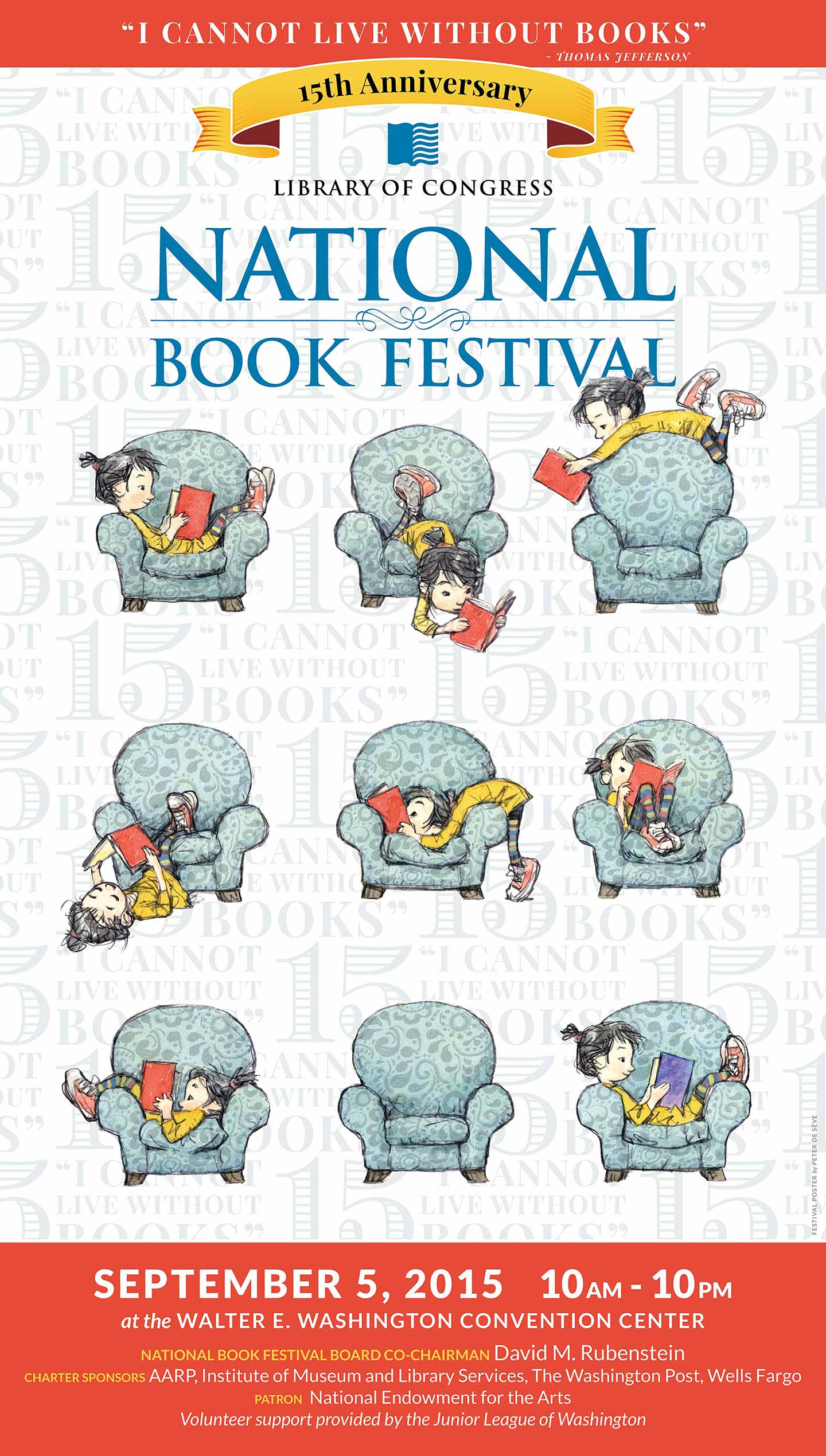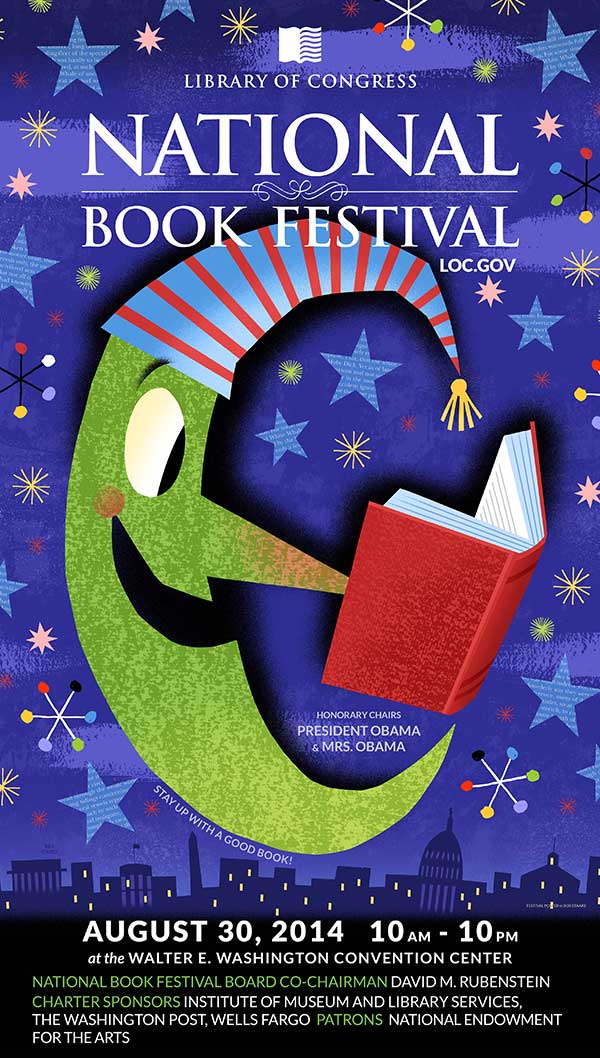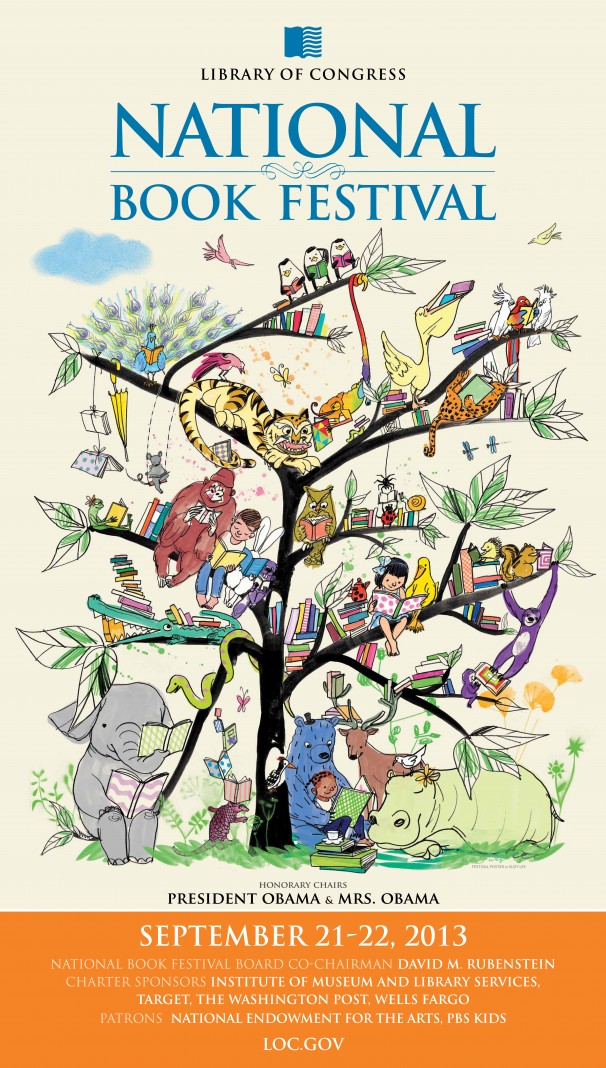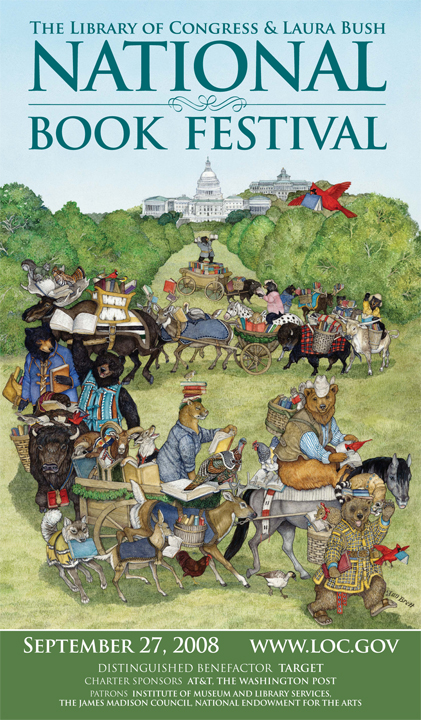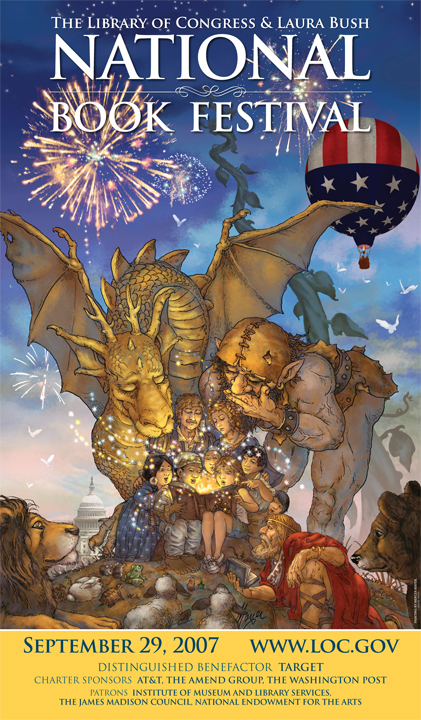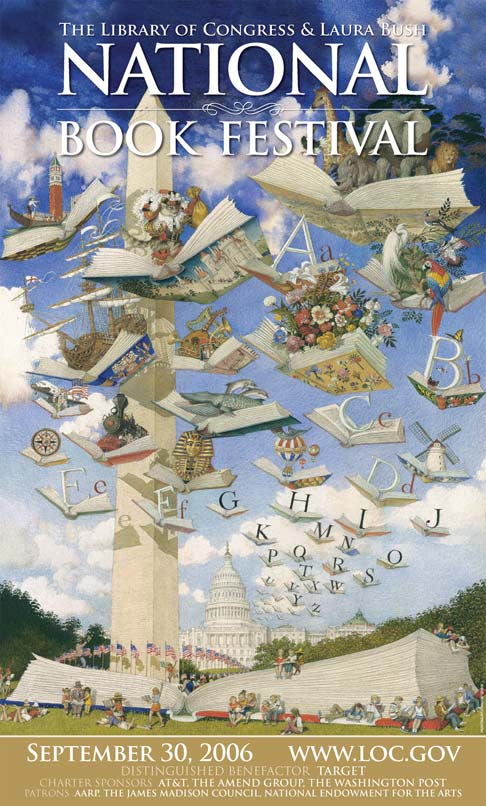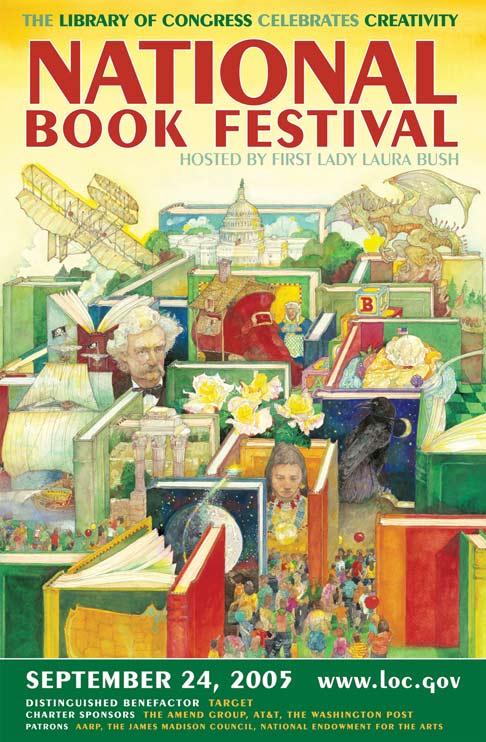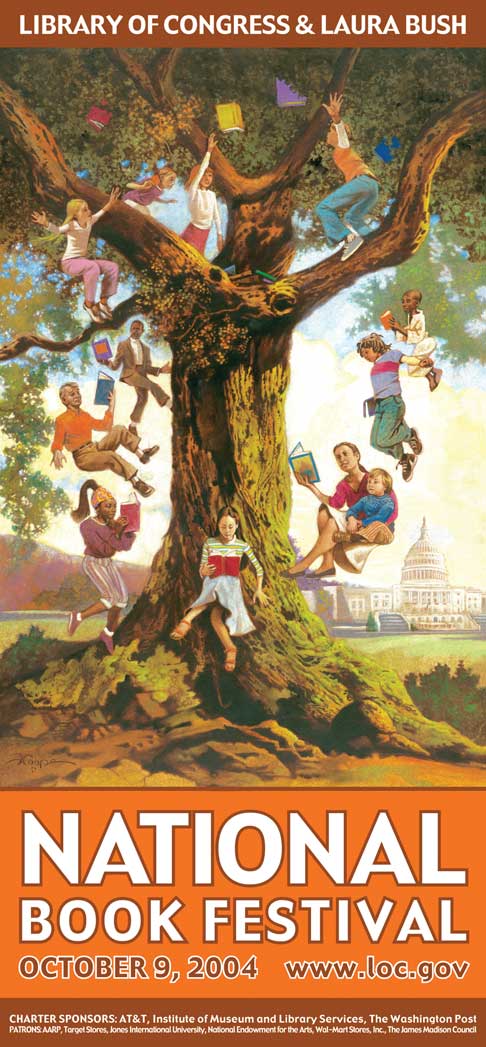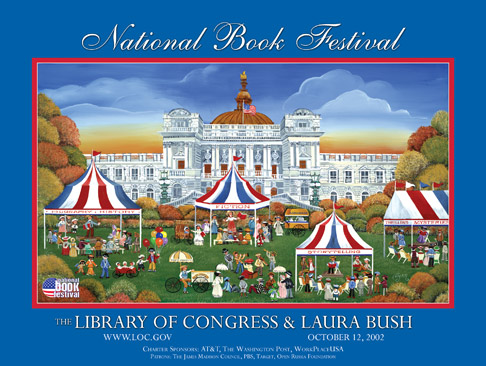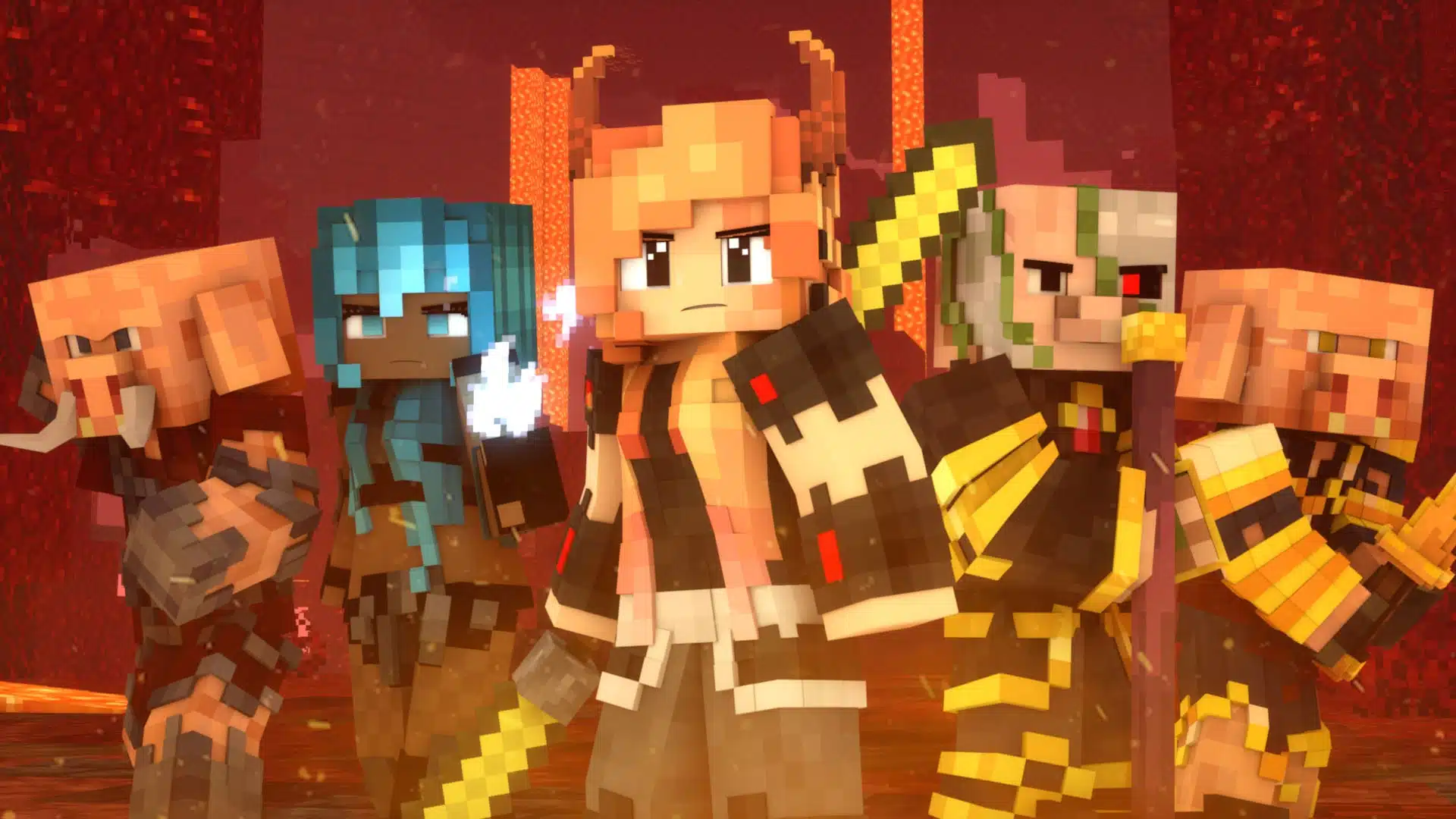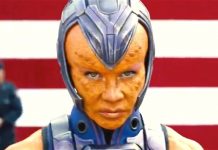Your tax dollars at work!
Not only does the Library of Congress sponsor the annual National Book Festival (taking place this Saturday!), but they archive lots of digital material online! (And if that doesn’t knock your socks off, the Library also collects and archives multimedia in a variety of formats… an original print of Star Wars: A New Hope… the artwork to Amazing Fantasy #15… field recordings of folk music from the 1930s… Bob Hope’s joke files… Jefferson’s library…)
Here is an almost complete list of graphic novel creators, illustrators, and related speakers who have been guests at the National Book Festival.
The Library of Congress is still adding content, so click the headlines if there isn’t a video now… there might be one soon.
2016
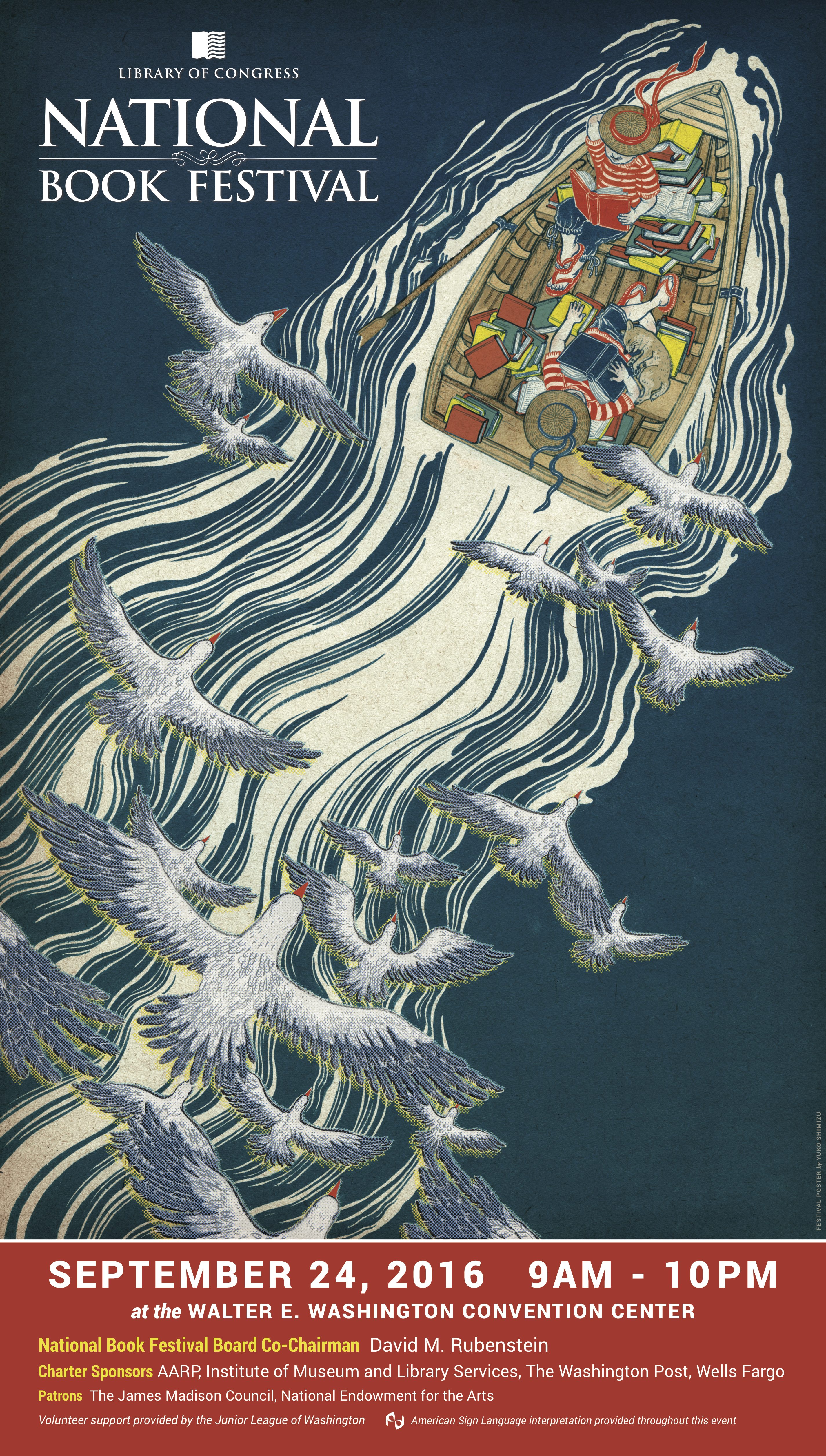
Michael Cunningham & Yuko Shimizu: 2016 National Book Festival
Michael Cunningham: Well, I would love to turn it over to Yuko, but the stories were pretty much finished and it was clear that a book of fairy tales needs illustrations. And we had a hard time finding anybody who felt right. The book was published by Farrar, Strauss and Giroux, a great and venerable publishing house and I sort of imagined that they would have reams of illustrators to call. They don’t. [laughter] They don’t really. They had some children’s books illustrators but nobody who felt … I kind of had a vague idea of the sensibility which would be sort of you know perverse but beautiful. I had a rough sense of the artists we were looking for and we weren’t finding that person, and I finally just Googled illustrators. [laughter] And came up with Yuko.
Yuko Shimizu: Wait is that how you found me?
Michael Cunningham: Yeah. [laughter] They didn’t tell you that.
Yuko Shimizu: No, no, no.
Michael Cunningham: I Googled you.
Yuko Shimizu: Oh, I had zero idea.
Michael Cunningham: No one at God damned FSG was doing shit about it. Excuse me, I’m sorry. It’s turrets like I will try to watch my language.
Yuko Shimizu: I got a call from the cover art director in [inaudible] FSG who I actually had worked with in past. And he, you know, he mentioned like you know Michael wrote these short stories and he want this to be illustrated and what do you think about it. And like we think, you know, you’re a perfect match and like I just assumed he found me because, you know, I have worked with him before, but it was a completely different kind of book because I’m a Japanese and I do a lot of you know Japanese period style art and it was one of [inaudible] books so it was very period Japanese, woodblock print type of work. It’s very different.
The book discussed can be found here.
Kate Beaton: 2016 National Book Festival
Darrin Bell & Michael Ramirez: 2016 National Book Festival
Darrin Bell: My– My mom, she didn’t tell me why but she told me that I couldn’t play with the same toy guns my other friends played with. She said I had to play with this bright green ugly translucent water gun.
Darrin Bell: And so I did, and so I was walking to– I was walking to a corner store one day, snuck out of the house, I was too young to leave by myself but I wanted to go get a comic book and play [inaudible].
Darrin Bell: So, I was– I was there with my gun and I was shooting the bench, I was shooting the stop sign and everything because there were Stormtroopers in the sky, and I was Hans Solo.
Darrin Bell: And I knelt down to fill up the gun from the puddle–
Darrin Bell: And there was a shadow and I looked up and it was a police officer.
Darrin Bell: And he had his gun out.
Darrin Bell: And he said that– he asked what I was doing there, he asked where I live, he said they had some complaints. He took my gun from me–
Darrin Bell: But if it had been instead of bright green translucent–
Darrin Bell: –plastic–
Darrin Bell: I might not be here right now.
Darrin Bell: And I was just being a regular kid.
Darrin Bell: So this is– this is important to me especially now that I have a son who is almost 3 and I look at him and I’m thinking what am I going to have to talk to him about this.
Darrin Bell: We– we’ve been with– whenever people bring guns to the park, we take him home and take him somewhere else because I don’t want him to want to play with them.
Darrin Bell: So, I don’t know how to do an awful lot of things.
Darrin Bell: But I know how to be a cartoonist.
Darrin Bell: And every time I sit down to draw a cartoon, every time something like this happens where some innocent– innocent person, Black, White, whatever, is shot by the police, I think about my son.
Darrin Bell: And I think I need to make the world better for him.
Darrin Bell: The only way I know how to do it is to keep talking about it.
Berkeley Breathed: 2016 National Book Festival
So I’ve only got a few minutes left, and I’m going to show the secret Watterson letters. Now some of you — has anyone been to Comic Con in the last few years? I did this there and it got infamous and I got in a whole lot of legal trouble about it. And we probably have some kids here, so I’m going to have to zoom through a couple of slides really fast. If any of you wonder what cartoonists do when they’re not doing their strip, they write to each other. In the old days we did, anyway. And Bill Watterson and I were friends via snail mail on actual onionskin paper for dozens and dozens and dozens of pieces of mail, because I had successfully got myself out of the contract for my syndicate and gotten my ownership back. He was desperately trying to do it. And he was not getting success. He was a very, very unhappy guy. So we had a lot of letters. Cartoonists like to draw on the bottom of their letters to each other, and that’s when their inner demons come out. So you’re about to see some of the letters that Bill Watterson wrote to me, and with the illustrations on the bottom, just to see what these guys are really like deep down inside. Again, these are, to me, I am the object of this stuff. I am the target, more specifically, and you’ll see that the sweet Calvin and Hobbes creator had a side to him that you might not have known about. And you have to know — a little bit of subtext is that I had won a Pulitzer prize, I had a TV special recently, and he was dead set on mocking me for both, largely because I was also known for spending a lot of the money on fast speed boats, which is about as opposite of the things he could imagine doing, since he lived on a bicycle. So this is after the Christmas special. Again, this is his drawings to me, so everything here is drawn by Watterson. Go ahead and quote scripture. This is real holiday entertainment. This is after the “A Wish For Wings That Work” Christmas special in 1987. He didn’t appreciate — he didn’t think the hairball should be in it. Now this is me in the boat. He’s drawing the syndicate guy on the dock with the money, and I’m stuffing the money into my boat, kicking my cartoon characters off while I go spend the money from the syndicate boss. And he’s saying, “Lazy freeloaders! I said none of you ride until your faces are on boxer shorts!” Remember, he sold nothing in his entire career.
Shannon Hale: 2016 National Book Festival
Are you planning any young adult books?
I am. I write for every age group from The Princess in Black up through adult. And in February, the next book I have coming out is called Squirrel Girl. It’s based on the Marvel super hero Squirrel Girl. Yes, got some [inaudible]. She’s fabulous, she has the proportional strength and agility of a squirrel. She speaks squirrel language, and she’s unbeatable. She has beat every, [inaudible] a Marvel villain including, Galactus and Thanos and Dr. Doom. And she’s hysterical, she’s so funny. I can’t wait for it. Since we have a sign language interpreter, I too want to add that one of the main characters in the story is deaf. And we have a really, a wonderful beta reader for Squirrel Girl who is deaf, developed a Squirrel Girl name sign name for us. Can I teach it to you? So I’ll teach it to everybody. Take your non-dominant hand, and make the S with it. Take your dominant hand, so if you’re right handed for example, and make the G. And then coming off the S, you do the swoop of a squirrel tail with the G, and that’s Squirrel Girl. Isn’t that awesome? I love that. All right, right over here.
Rep. John Lewis & Andrew Aydin: 2016 National Book Festival
Andrew Aydin: So let me give you a brief summary of what I have learned, because I noticed we have a lot of teachers, and we have a lot of students in here, right? How many of you all are teachers or educators or librarians? That’s pretty good. That’s pretty good. How many of you are students? That’s very good. Oh yeah, somebody brought their class. So let me tell you the three things I learned in doing March. You take this with you. You tell them Andrew Aydin told you. Like that will make a difference. First of all, show your work. All right. In the process of doing March, I had never written a book. You guys hold up March: Book One. People talk about it like its cannon. That is the first book I ever wrote. I did not know what I was doing, but the thing that stuck with me is that over and over and over again as I interviewed the congressman, as I read these books, as I took notes, I kept showing my work so that I had a full notebook of everything I needed to know, and so when your math teacher tells you you have to show your work, and you say but the answer is seven! Why are we debating this? I’m telling you, it’s because you need to build that skill. You need to build that habit so one day you may be doing something completely unrelated and it will save you. So show your work. Number two, don’t be afraid to be laughed at. From the very moment I mentioned that I enjoyed going to Comic-Con, and yes, I love going to Comic-Con. My colleagues on the hill, a very uptight, professional, political operatives, they laughed at me. And every time I had a crazy idea, John Lewis you should join Facebook. That’s silly, why would you do that, you nerd? And they laughed at me over and over and over again. Well, who’s laughing now?
And number three, question your sources. I think, yeah right. Yeah. Yeah, how about have sources? But that’s another battle. Over and over and over again, I was able to defer to John Lewis for an answer, because what I found is some of the works that are in our classrooms, that are in our libraries, they don’t really have all their facts straight. And we’re very lucky, because with March, and the creation of it, we experienced the first digitization of SNCC’s primary records. And so when we had a question, and John Lewis didn’t know the answer, and we couldn’t find it in a book, or there were more often than not conflicting accounts in two different books, we went to the after action reports. We went to the Watts line reports. We went to the meeting minutes. In fact, there’s a long scene in Book Three that you’ll read about where they decide the fate of Mississippi Freedom Summer. Nate has dubbed it the Council of Elrond. Lord of the Rings. But it is that moment. And people ask me, well, how did you know what they had to say on that in that meeting? And I say well I had the meeting minutes. So I just wrote down what they said. It’s not very hard.
If you do those three things, you’re off to a good start. But as I mentioned in the beginning, I was raised by a single mother. I’ve been on scholarships since the fourth grade. Another couple years of this best seller status, I might pay off my student loans. But out of it all, the greatest gift that I got was a father, was John Lewis.
Juana Medina: 2016 National Book Festival
Jerry Pinkney: 2016 National Book Festival
But the case cover, it’s not only the objects that you find in the book that the grandpa hides, but also on the case cover are the tools that I used to make the book. So you’ll find in this illustration pencils that I used, pastels, of course, water colors, and pencils. Now, pencils is the really the instrument or the drawing tool of choice. And a little story about that because I had an interview earlier. And we were talking about the love of drawing. And I said, “You know what’s so cool about all this?” I was just thinking about this. I said, “If you read about me, and I write a lot of pieces, essays on my process, and the medium is pencil and water color on paper.” Okay. So I write a lot about the fact that, again, that tool — instrument of choice — to help me make marks is the pencil. Now, here’s the thing that I just thought about. When I was a kid growing up, I didn’t have access to art materials.
My parents weren’t museum or gallery visitors at all. They didn’t have a cool understanding of what an artist was. What’s interesting is although they supported their young son’s need to draw, so I always had materials at hand. Here’s the cool part. I grew up on a very small street in the Germantown section of Philadelphia. All of the neighbors were African-Americans who migrated south. Outside of that world were Jewish and Italian communities. So in the ’40s we were somewhat isolated. In order to keep the young boys somewhat busy in a positive way, we were encouraged to draw. And my parents didn’t have a sense about what art might lead to, but the boys were actually encouraged to draw as a positive way to use that time. I’m going to go back to the fact that the pencil as instrument of choice on that block of row homes, and the end of that block there was a factory. The factory was a pencil factory. And my grandfather worked in the factory. And he would bring home lots of pencils. So here’s the thing about being an artist for you parents out there and grandparents that might have children that are interested in drawing — that key piece that started when I was a very young child, the fashion and the love for making a mark and then making a mark with the pencil. And that has stayed with me over the course of some almost — my first book was published in 1964. It was done in pencil with color washes. And today when I get up in the morning and most days when I get up in the morning and I walk to the studio, I sit down at my drawing board, and most often I pick up a pencil. Thank you, Grandfather Charles. Thank you, guys. Well appreciated.
Ed Piskor: 2016 National Book Festival
Damon Locks: I see some — look like comic fans, look like there are some young people. This is the classic question, but like what advice would you give in terms of like making comics?
Ed Piskor: I think that it’s best to just be into it for the right reasons. Just don’t expect to make a lot of money upfront. Do it for the love. Do it almost for the tradition. Do it because you can’t not do it. And you have to be relentless. You have to almost punt your teenage years away. When all your friends are partying and smoking weed and having sex —
Damon Locks: Don’t do that, don’t do that.
Ed Piskor: If you’re drawing, don’t worry about that. If it pays off later, something like that. You have to punt your teenage years, and you have to punt your 20’s and then the rest of your life can be clear sailing. But — so it really takes — I had this idea that it takes 20 years to get to be good enough to be publishable and then it’s going to take another 20 years to create your masterpiece. Like I truly sort of believe that. [Inaudible] trajectory like I haven’t done my masterpiece yet, but I keep learning and I’m still a student like any teenagers or whatever who are here. I’m the same as you. I’m still learning stuff. It’s just I’ve been putting in a little — a few more hours.
Noelle Stevenson: 2016 National Book Festival
Michael Cavna: Nice, nice, now in you know being 17, 18, 19 that can be a time of enormous change and you were going through change, it’s just incredibly cool that she’s a shapeshifter and what that speaks to, identity and feelings toward identity. Could even be identity politics, can you talk a little bit about why a shapeshifter?
Noelle Stevenson: Yeah, I mean that’s — it’s the point of the whole book I think is identity and what was interesting to me about Nimona was a spoiler like — she doesn’t have a default form, which most shapeshifters do. So you kind of assume because you meet her as this girl that this is who she really is but it isn’t, and I think that really — because I did make Night Shade up you know when I was in high school. I had been homeschooled until my junior year and then I want to public high school for two years and I just had no idea what I was doing there, like who I was.
Michael Cavna: I just have to — how was that, was that —
Noelle Stevenson: I just skated through, you know, I like didn’t — I was in the drama club and the drama club is kind of in a separate building away from the rest of the school and I would just cut class all the time and like — I was friends with the librarian and the art teachers and the drama teacher so I would just cut class an go and read or I’d cut class and go and like — I mean I always had a note or something, I’d be like I’m painting sets at drama club, I’m working on a children’s book in art class. So they would just let me walk out, I was not used to sitting at a desk and chair and having people be like here’s your worksheet, do this in 30 minutes. I’m like I’m done, can I go, like no you have to stay. I’ve been home schooled for this long, my mom gives me a list of things to do, I do them and then I can go play. Like I mean I was in high school so I guess I wasn’t like playing but I want to go eat a bagel or whatever.
Raina Telgemeier: 2016 National Book Festival
So what’s next? I mean I’ve had a book out for a week and a half. So, like shouldn’t I take a little bit of time off? Of course not, that’s not how it works in this business. We’re always thinking about what’s next. So for me, it’s going to be– this is just a big spoiler for you guys. I’m going to do another memoir and this one’s going to be about me and my dad and a certain book that he gave me to read when I was 10 years old and how that book changed my entire life.
[…]
Are you going to write any more books about your life?
Raina Telgemeier: Well, the next one I’m working on is definitely going to be about life. And then the two after that that I have contracted, I can’t talk too much about right now, but I do have three more books that are going to be coming out from Scholastic in the next six years. So at least one will be a memoir. Yeah.
Hervé Tullet: 2016 National Book Festival
Gene Luen Yang: 2016 National Book Festival (morning)
Petra Mayer: So what makes comics — I mean The, The Library of Congress recognized your work with comics and education. What do you think makes comics such a good medium for conveying information to kids?
Gene Luen Yang: Well really I, I mean I think different kinds of information are conveyed best in different ways. And the thing about comics is that at least in American culture for decades, and decades, and decades, there education potential just wasn’t recognized. I mean it dates back to the 40’s and 50’s for really intermental reasons. I, I don’t think comics is necessarily the best medium of communication. It’s the one I feel most like heart attachment too. But I don’t think it’s necessarily the best one I just think it’s another tool in the tool box. And there’re specific kinds of information that are best communicated through comics. For instance all of you have seen those instruction packets that come with Lego sets. Those are basically comics. There’re sequential images right? And can you imagine reading text to tell you how to put together a, a Lego set. It would be practically impossible. And I would even argue that comics works better than video for that. Because when you’re watching a video the, the person making the video isn’t necessarily going at the same rate as you want to go to build that Lego set. So that’s just a really, really simple example.
Gene Luen Yang: 2016 National Book Festival (evening)
Gene Luen Yang: Sure. I mean I think growing up in America, growing up with American stories, it was very difficult for me to find characters that look like me in the stories that I was watching and in the stories that I was reading. And I think, you know, there’s a professor by the name of Rudy Bishop who talks about how literature serves as both windows into other people’s lives and mirrors into our own and how kids really need to grow up with those windows and mirrors. And I felt like I had a ton of windows; I didn’t really have any mirrors. So, when I encountered Dwayne McDuffie’s work, you know, he used to write an online column and he talked about his love of Black Panther, who is really this flawed character, at least in terms of representation, but he talked about how Black Panther– reading a Black Panther comic made him feel like African-Americans, black people, black people were inevitable. They became inevitable. They were no longer incidental to the story. And when I read that column, I though he is talking about something that I myself had experienced. The talk that I gave at the gala really came out of my– it really came out of my experience as a teacher at Hamline University. I teach creative writing through a university in Minnesota and one summer– the summer right before that gala, actually, we started talking a lot about diversity. And it was part of a larger conversation that all books are having. All storytelling. We’re having it in terms of our movies, our television series, and our books. And, you know, a lot of my students expressed fear about writing diverse characters. They were worried about getting it wrong and what my response to that is– well, in some ways, that’s kind of good. It’s good that you’re scared that you’re going to get it wrong, but what you should do with that fear is not necessarily shy away from the story you wanted to tell, that fear should really just drive you to do your homework. It should drive you to do your research. I really do think, though, that the diversity question– it’s two different questions. There is the question for the writer and then there is the question for the gatekeeper.
Gene Luen Yang: 2016 National Book Festival [Podcast]
2015
“I also loved comics. This comic was sort of before my time. It’s the EC Comics from the ’50s but on the cover is a guy name Frank Frazetta who I discovered when I was about 12 or 13 and just loved the way he drew. He still remains one of my heroes. This in fact is a piece of artwork of his that I own. It’s kind of incredible because it’s a rough for a finished piece and it’s about this big. It’s tiny but I always admired his dynamic draftsmanship and his sense of exaggeration here too. I thought I was going to be a comic artist. I thought I was going to draw for Spiderman. That was my plan anyway but I also loved this gothic horror kind of thing and there were comic books out at the same time called “Swamp Thing” illustrated by a guy named Bernie Wrightson. In a way the two in combination really described what I was into when I was about 12 or 13.”“Here is–this is an illustration for “Entertainment Weekly” for when they were actually discussing producing “Batman the Musical” and this is when that was really a silly idea.”
“This is another sketch that wasn’t for anything it’s called “Job of a Husband” and this was for–I was invited to contribute to a book of “Star Wars” art and I was not a big “Star Wars” fan. I was a “Star Trek” fan but this was the big hard cover that they asked people outside of the “Star Wars” world to give their own interpretations of a moment or those characters and this one is called “Easy Being Green it is Not” and I knew I had a good idea, I have to say. I knew I had a good idea when I realized that not only are they both green but they’re both Muppets really and they essentially come out of the Jim Henson Studios so George Lucas bought this by the way. “
Cece Bell: 2015 National Book Festival
Stephan Pastis: 2015 National Book Festival
Okay so fast forward about a year. I do another strip where Cathy Guisewite, the creator not the cartoon character, Cathy Guisewite– I’m going to use a euphemism– was sort of playing naked twister with some other cartoon creators in my comic. And so this is not the character, so I put my little lawyer hat on and a different legal standard may apply. So I actually need permission to do this. So I get her number from the syndicate, and I have never spoken to her before. So I call her and I say Ms. Guisewite, my name is Stephan Pastis and I do the comic strip “Pearls Before Swine” and there is three seconds of utter silence followed by, I know who you are.
Dan Santat: 2015 National Book Festival
Graphic Novels Panel 1 – Knight, Alcaraz, Stantis: 2015 National Book Festival
Lalo Alcaraz: I like to do memes and I hate to submit this as an old-school cartoonist, but memes are cartoons also because they’re a picture with a caption. And I’m usually a snob about all the hard work that I put in to be a cartoonist, but then memes are cool and I like to participate too. And this one is like, I mean it’s true. Pocho.com is my humor website.
[…]
Michael Cavna: Now we’ll try to keep this quick. One thing I talked with Scott Stantis about was he had never admitted, you know, admit is not the right word, he had never shared with the world that he was a victim of child abuse. And the NFL last season kept having all these domestic violence cases and abuse cases, and you know, all these gentlemen are able to do comics journalism as well as single-panel and just gag oriented. And so Scott shared this and it’s just an incredibly powerful, personal work. So I’d like for him to talk about it.
Scott Stantis: Thank you. Thank you. Real quick, I’m just going to blast through this because the guy showed us the signs so. I have a poster of that piece it’s called, “The Beatings Never Really Stop,” and it went totally crazy viral. And it’s been — every time I speak about it, do specific talks about that, and it’s remarkable the response to it has been overwhelming. Last time I spoke about it this fellow stood up, and he was a mountain of a Southside Chicago Irishman. And he just starts telling his story about his dad and the abuse, and he starts crying. It was a — it’s just, and it’s allowed. I’ve been told by the national organizations that handle abuse and this kind of clearinghouse for them that men don’t talk about it. And so that’s why the piece I think was so powerful and why people seem to respond to it.
Graphic Novels Panel 2 – Noomin, Lasko-Gross, Robbins: 2015 National Book Festival
Jarrett J. Krosoczka: 2015 National Book Festival
Jennifer L. Holm: 2015 National Book Festival
David Weber: 2015 National Book Festival
Jerome Charyn: 2015 National Book Festival
2014
Bob Staake: 2014 National Book Festival (poster artist)
National Book Festival Author’s Gala at the 2014 Library of Congress National Book Festival in Washington, D.C.
Gene Luen Yang speaks at the NBF Gala, starting at 19:35, or click the headline above.
Rep. John Lewis & Andrew Aydin: 2014 National Book Festival
Brian Biggs: 2014 National Book Festival
Vivek Tiwary & Kyle Baker: 2014 National Book Festival
Bryan Lee O’Malley: 2014 National Book Festival
Liza Donnelly: 2014 National Book Festival
Jeff Smith: 2014 National Book Festival
Raina Telgemeier: 2014 National Book Festival
Gene Luen Yang: 2014 National Book Festival (Graphic Novels)
Gene Luen Yang: 2014 National Book Festival (Teens)
Patrik Henry Bass & Jerry Craft: 2014 National Book Festival
Jeffrey Brown: 2013 [sic] National Book Festival
2013
Suzy Lee: 2013 National Book Festival (poster artist)
Lynda Barry: 2013 National Book Festival
Fred Chao: 2013 National Book Festival
Jennifer & Matthew Holm: 2013 National Book Festival
Gilbert Hernandez: 2013 National Book Festival
Jaime Hernandez: 2013 National Book Festival
Jonathan Hennessey: 2013 National Book Festival
Jon Scieszka: 2013 National Book Festival
2012 (first Graphic Novel pavilion)
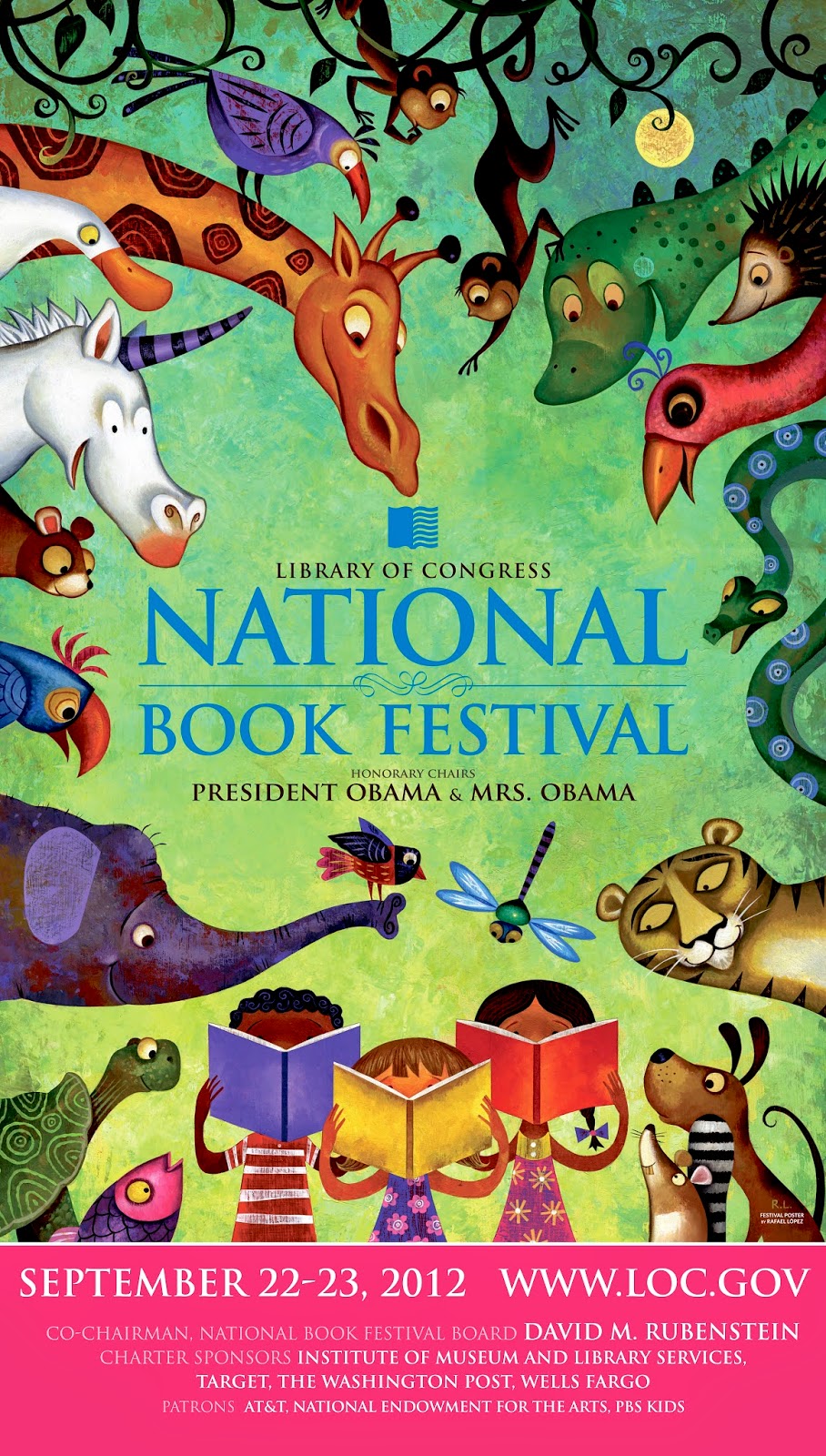
Rafael Lopez: 2012 National Book Festival (poster artist)
Craig Thompson: 2012 National Book Festival
Podcast: Craig Thompson: 2012 National Book Festival
A Wrinkle in Time: 2012 National Book Festival
At the 2012 Library of Congress National Book Festival, Hope Larson, Anita Silvey and Leonard Marcus discuss the classic book “A Wrinkle in Time” by Madeleine L’Engle upon its 50th anniversary.
Jeff Kinney: 2012 National Book Festival
Raina Telgemeier: 2012 National Book Festival
Jarrett J. Krosoczka: 2012 National Book Festival
Peter Reynolds: 2012 National Book Festival
2011 (Graphic Novels Super Session)
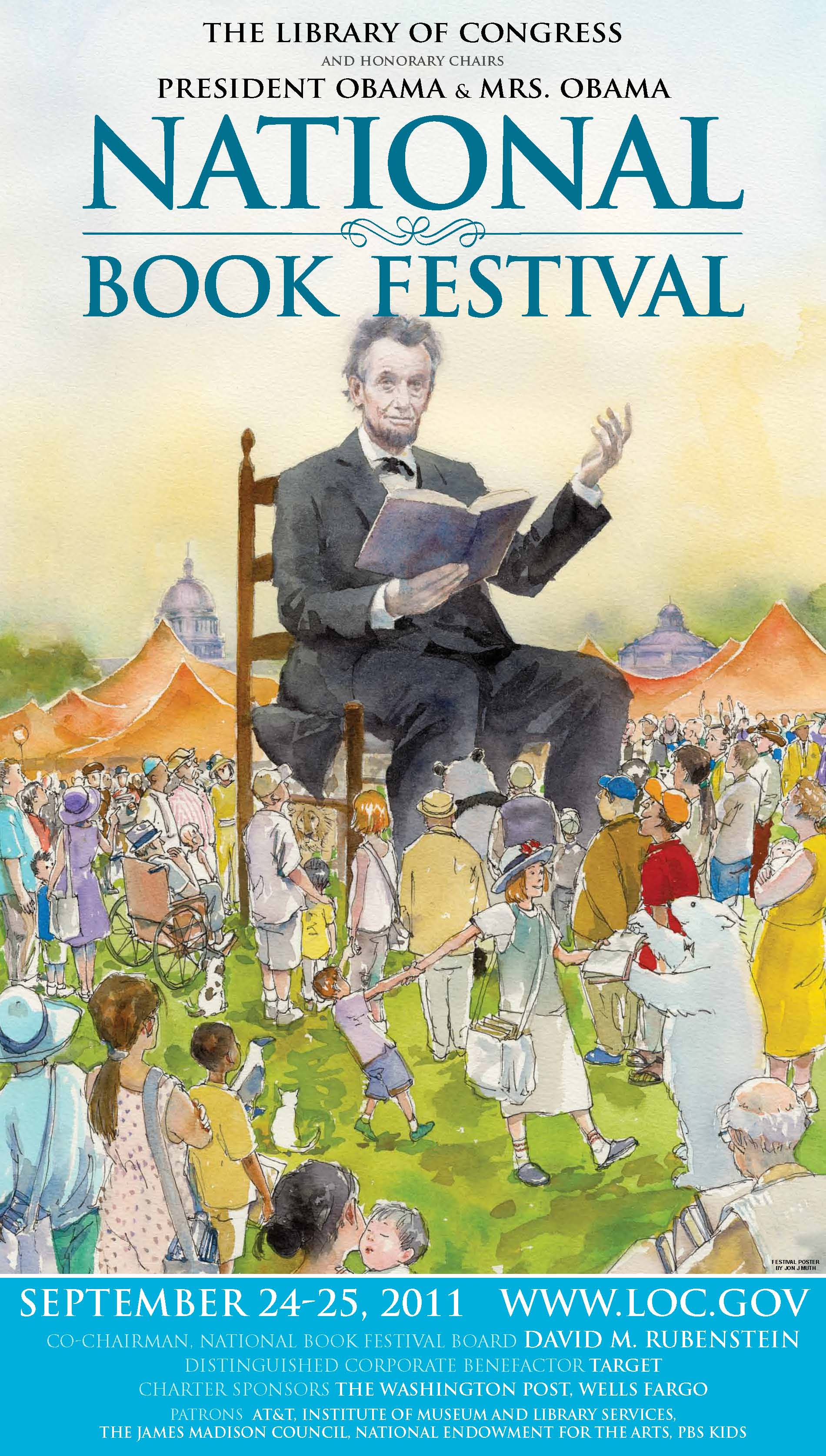
Jon J Muth: 2011 National Book Festival
Mark Pett and Gary Rubinstein
Kazu Kibuishi: 2011 National Book Festival
Harry Bliss: 2011 National Book Festival
Eric Wight: 2011 National Book Festival
Richard Thompson: 2011 National Book Festival
Allen Say: 2011 National Book Festival
Jarrett J. Krosoczka: 2011 National Book Festival
2010
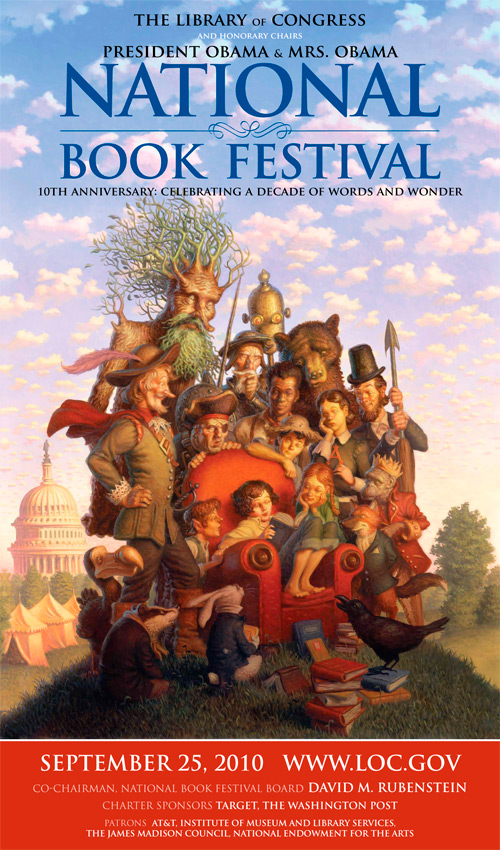
Peter Ferguson (poster artist)
Jeff Smith: 2010 National Book Festival
Jules Feiffer: 2010 National Book Festival
Norton Juster & Jules Feiffer: 2010 National Book Festival
Diana Gabaldon: 2010 National Book Festival
2009
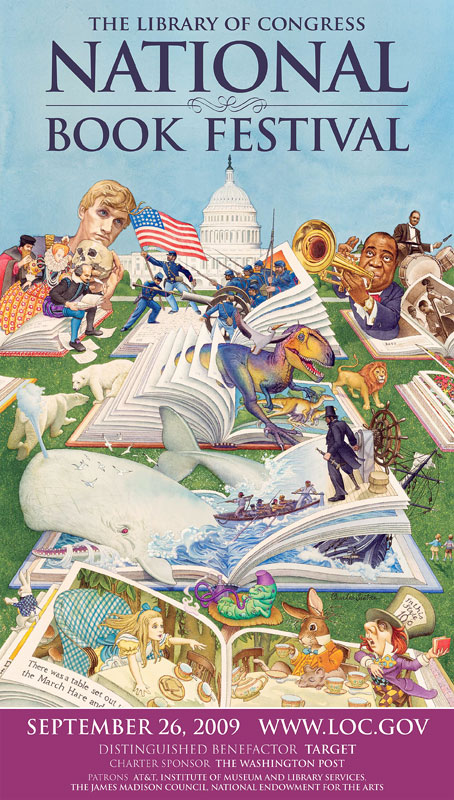
Charles Santore: 2009 National Book Festival
Mo Willems: 2009 National Book Festival
Jeff Kinney: 2009 National Book Festival
2008
Jan Brett (poster artist)
Neil Gaiman: 2008 National Book Festival
2007
Mercer Mayer (poster artist)
Gene Luen Yang: Book Fest 07
“So instead what I’d like to do is I’d like to talk about how I got into comics. Does anybody want to make comics? Anybody want to make comics, interested in making comics? Okay, I’d like to start with giving you three compelling reasons why comics are a bad medium, why you should stay away.”
“So we started making comics; we created two different issues. The very first one was called Spade Hunter. It was a super hero comic that was based off of both Captain America and Robin Hood. He threw a shield like Captain America, but he dressed like Robin Hood.
[laughter]
That was the original twist. And the second one was Transsmurfers, which was about Smurfs who could transform into robotic fruit.
[laughter] [applause]
And these fruit could fly around and fight crime. [laughter] That was an amazing experience. As you were told, we sold these around campus for 50 cents a pop. We would color them by hand because there were no color photocopiers at the time. And then we took all of our proceeds and donated it to the Statue of Liberty Fund so that they could restore the Statue of Liberty.
[applause]
Thanks. All $7.50 went straight to the Statue of Liberty.”
Jennifer L. Holm: Book Fest 07
2006
Gennady Spirin (poster artist)
Mo Willems: 2006 National Book Festival
2005
Jerry Pinkney (poster artist)
Neil Gaiman: Book Fest 05
Also, Neil himself reflects on his experience at the NBF.
Harry Bliss: Book Fest 05
2004
Floyd Cooper (poster artist)
Neil Gaiman
David Macaulay
John Lewis
2002
Carol Dyer (poster artist)
Brian Selznick
Allen Say
Jules Feiffer
And in 2000 (before the National Book Festival existed):
Jenette Kahn


